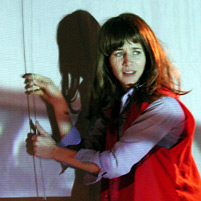Riot Grrrl Resonates

The early '90s pioneering punk feminist movement Riot Grrrl inspired many people around the world to pursue socially and politically progressive careers as artists, activists, authors and educators.
"Alien She," an exhibition on the movement's lasting impact, is now on view at Carnegie Mellon University's Miller Gallery in Pittsburgh before touring nationally. The exhibit has already garnered attention from the national media.
The exhibition focuses on seven contemporary artists working in a wide range of disciplines, including visual art, music, documentary film, new media, writing and performance, and provides a view into the passion and diversity of the original Riot Grrrl movement.
Riot Grrrl formed in reaction to violent sexism, racism and homophobia in the punk music scene and in the culture at large. Emphasizing female and youth empowerment, collaborative organization, creative resistance and DIY ethics, Riot Grrrl helped a new generation of young women to become active feminists who created their own culture and communities to reflect their values and experiences.
The movement spread, with chapters opening in at least 29 states and 21 countries, and with many new chapters forming in recent years.
Exhibition curators Astria Suparak of CMU's Miller Gallery and Ceci Moss of Yerba Buena Center for the Arts in San Francisco note that Riot Grrrl's influence on contemporary global culture is increasingly evident, from the Russian collective Pussy Riot's protest against corrupt government-church relations to the popular teen website "Rookie" and the launch of Girls Rock Camps and Ladyfest music and art festivals around the world.
"Riot Grrrl fostered community, action and creation," Suparak said. "This exhibition provides a view into the passion and diversity of the original Riot Grrrl movement and highlights how these ideas have broadened, evolved and mutated in the work of contemporary artists."
The exhibiting artists are Ginger Brooks Takahashi (North Braddock, Pittsburgh), Tammy Rae Carland (Oakland, Calif.), Miranda July (Los Angeles), Faythe Levine (Milwaukee), Allyson Mitchell (Toronto), L.J. Roberts (Brooklyn) and Stephanie Syjuco (San Francisco).
Each artist is represented by several projects from the last 20 years, including new and rarely seen works, providing an insight into the development of their creative practices and individual trajectories.
Of the historic section of the exhibition, Moss said, "This is a living history, not a sealed past. By representing numerous voices and experiences, rather than outlining one single definitive story, we hope the historical section of the show will reflect the multiplicity that was such an integral part of the original movement."
Hundreds of self-published 'zines and hand-designed posters from institutional and personal archives were solicited through open calls, word-of-mouth and invitations, similar to the way Riot Grrrl expanded.
Music playlists represent different Riot Grrrl scenes across the United States, Canada, South America and Europe. These playlists are guest-curated by musicians, DJs and music label owners internationally and accompanied by records, set lists, band T-shirts and other ephemera.
Video interviews and ongoing, online projects produced by the gallery, like the Riot Grrrl Census and Riot Grrrl Chapters Map, provide an expanded oral history.
In addition, the Miller Gallery is hosting public programs including workshops, discussions, film screenings, and dance parties in collaboration with several local groups and institutions.
The Miller Gallery is in the Purnell Center for the Arts on CMU's Pittsburgh campus. The gallery is free and open to the public from noon to 6 p.m., Tuesday through Sunday.
Photo: The Swan Tool, performance by Miranda July, 2001, photograph by David Nakamoto
Related Links: Miller Gallery | College of Fine Arts | Huffington Post article
